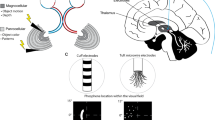Abstract
The absence of effective treatments for retinal degenerative diseases has inspired several laboratories to pursue the development of a retinal prosthetic. In our laboratory, we have focused on the subretinal approach, using an array of photodiodes housed within a silicon chip. These photodiodes generate electrical current in response to wavelengths ranging from 500–1100 nm. Because the native retina is traditionally thought to be insensitive to wavelengths beyond ∼750 nm, we and others have attempted to isolate implant-mediated electrophysiological responses from those of the native retina by using longer wavelength stimuli in the near infrared range. Evoked potentials recorded over the visual cortex in response to infrared stimuli have been reported as evidence of a functional subretinal implant due to the typical physiological characteristics of the waveform: a direct relationship between amplitude and intensity, increased amplitude over the visual cortex, and repeatability of the response. However, these results should be interpreted with caution since here we report an unappreciated sensitivity of the native retina to infrared light under dark-adapted conditions.
Similar content being viewed by others
REFERENCES
Sharma RK, Ehinger B. Management of hereditary retinal degenerations: Present status and future directions. Surv Ophthalmol 1999; 43: 427–44.
Eckmiller R. Goals, concepts, and current state of the retina implant project: EPI-RET. In: Hollyfield JG, Anderson RE, LaVail MM, eds. Retinal Degenerative Disease and Experimental Therapy, New York: Plenum Press, 1999: 487–96.
Humayun MS, Weiland JD, de Juan E Jr. Electrical stimulation of the human retina. In: Hollyfield JG, Anderson RE, LaVail M, eds. Retinal Degenerative Disease and Experimental Therapy, New York: Plenum Press, 1999: 479–85.
Peachey NS, Chow AY. Subretinal implantation of semiconductor-based photodiodes: Progress and challenges. J Rehab Res Devel 1999; 36: 372–8.
Rizzo JF, Loewenstein J, Wyatt J. Development of an epiretinal electronic visual prosthesis. The Harvard Medical School – Massachusetts Institute of Technology Research Program. In: Hollyfield JG, Anderson RE, LaVail MM, eds. Retinal Degenerative Disease and Experimental Therapy, New York: Plenum Press, 1999: 463–9.
Zrenner E, Stett A, Weiss A, Aramant RB, Guenther E, Kohler K, Miliczek K-D, Seiler MJ, Haemmerle H. Can subretinal microphotodiodes successfully replace degenerated photoreceptors? Vision Res 1999; 39: 2555–67.
Zrenner E, Weiss S, Stett A, et al. Are subretinal microphotodiodes suitable as a replacement for degenerated photoreceptors? In: Hollyfield JG, Anderson RE, LaVail MM, eds. Retinal Degenerative Disease and Experimental Therapy, New York: Plenum Press, 1999: 497–505.
Chow AY, Pardue M T, Chow VY, Peyman GA, Liang C, Perlman JI, Peachey NS. Implantation of silicon chip microphotodiode arrays into the cat subretinal space IEEE Trans Rehab Eng 2001; 9: 86–95.
Chow AY, Chow VY. Subretinal electrical stimulation of the rabbit retina. Neurosci Lett 1997; 225: 13–6.
Peyman GA, Chow AY, Liang C, Chow VY, Perlman JI, Peachey NS. Subretinal semiconductor microphotodiode array. Ophthalmic Surg Lasers 1998; 29: 234–41.
Ball SL, Pardue MT, Chow AY, Chow VY, Peachey NS. Subretinal implantation of photodiodes in rodent models of photoreceptor degeneration. In: Anderson RE, LaVail MM, Hollyfield JG, eds. New Insights Into Retinal Degenerative Diseases, New York: Plenum Press, 2001; in press.
Peachey NS, Chow AY, Pardue MT, Perlman JI, Chow VY. Response characteristics of subretinal microphotodiode-based implant-mediated cortical potentials. In: Hollyfield JG, Anderson RE, LaVail MM, eds. Retinal Degenerative Diseases and Experimental Therapy. New York: Plenum Press, 1999: 471–8.
Gastaut H, Regis H, Lyagoubi S, Mano T, Simon L. Comparision of the potentials recorded from the occipital, temporal and central regions of the human scalp, evoked by visual, auditory and somato-sensory stimuli. Electroencephalography and Clinical Neurophysiology, Supplement 26, 19–28.
Stensaas SS, Eddington DK, Dobelle WH. The topography and variability of the primary visual cortex in man. J Neurosurg1974; 40: 747–55.
Baylor DA. Photoreceptor signals and vision. Invest Ophthalmol Vis Sci 1987; 28: 34–49.
Author information
Authors and Affiliations
Rights and permissions
About this article
Cite this article
Pardue, M.T., Ball, S.L., Hetling, J.R. et al. Visual evoked potentials to infrared stimulation in normal cats and rats. Doc Ophthalmol 103, 155–162 (2001). https://doi.org/10.1023/A:1012202410144
Issue Date:
DOI: https://doi.org/10.1023/A:1012202410144




